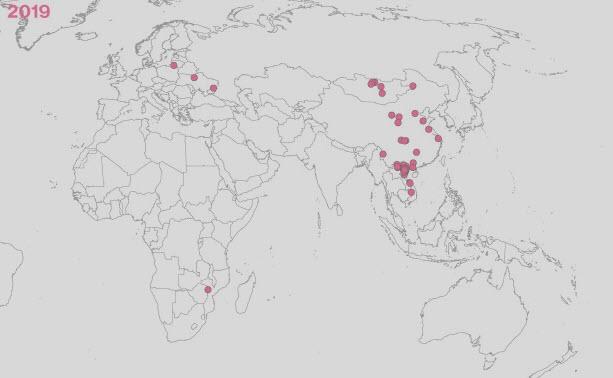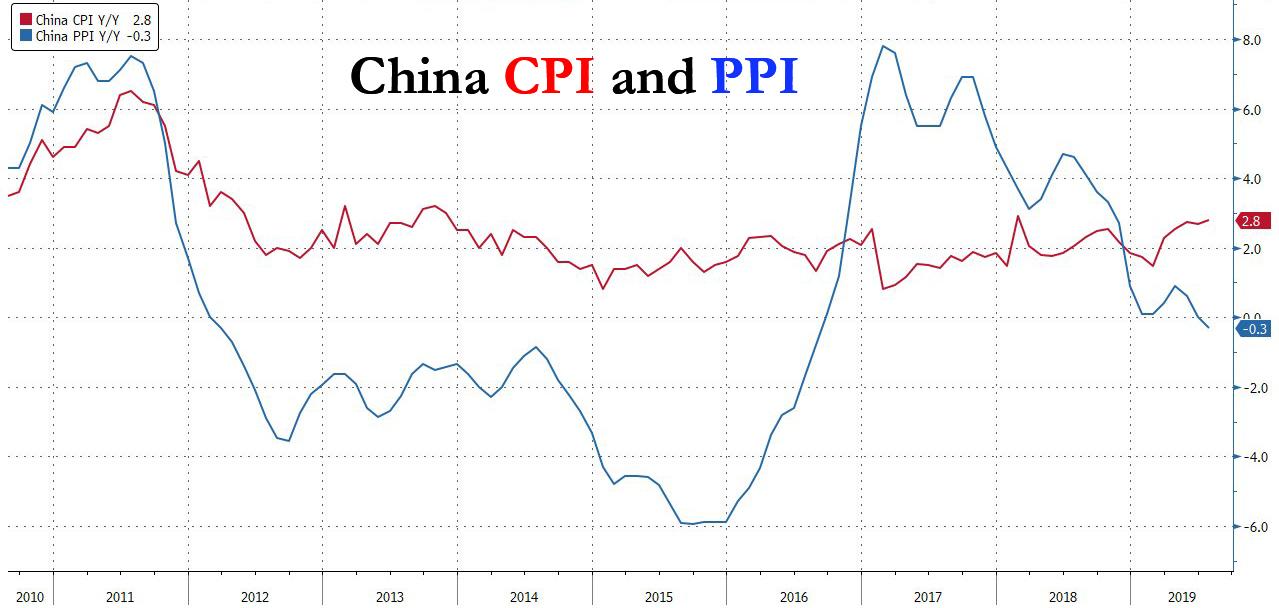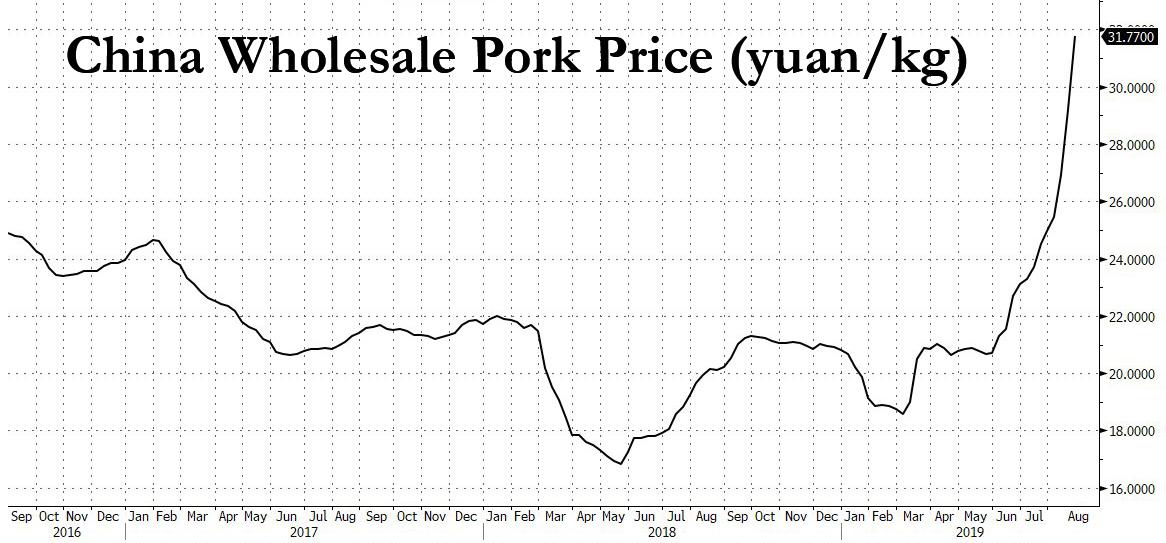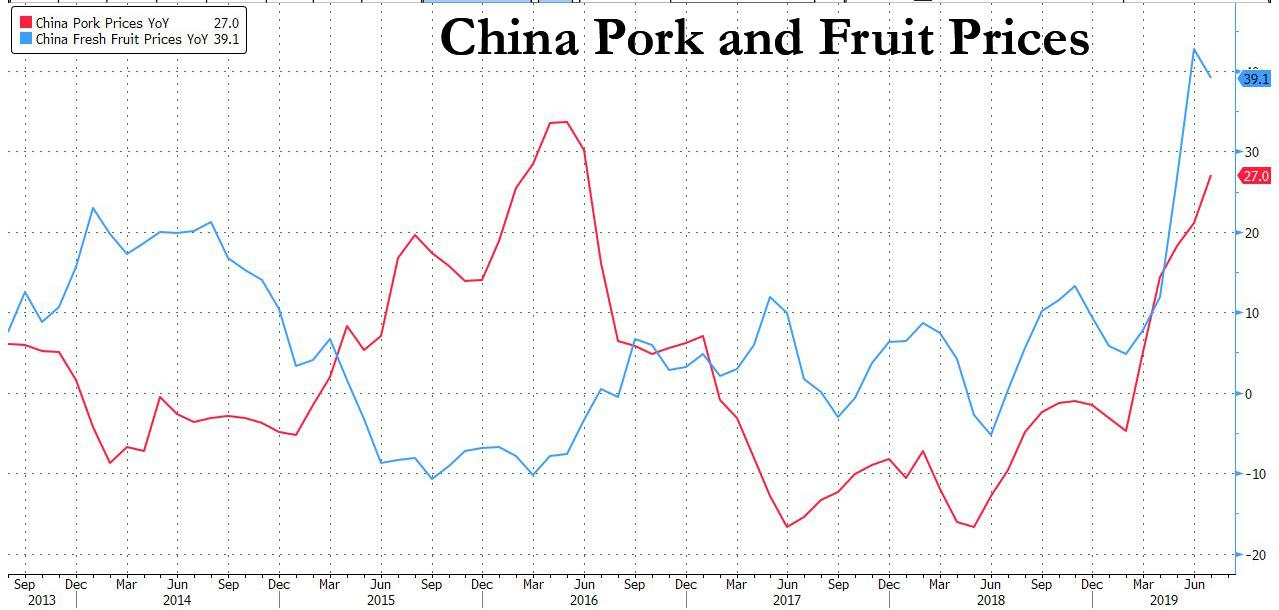One could see it coming from a mile away, but still the breakout in Chinese pork prices as a result of the country’s “pig ebola” outbreak and the ongoing trade war with the US, is a sight to behold.
As the chart below shows, pork prices in China have soared to record highs in the past two weeks, adding pressure on a government trying to contain food-price inflation during the trade war with the U.S., even as the country’s Producer Price index posted its first negative print in 3 years, putting China in a bind: contain soaring food inflation, or stimulate the economy and risk an angry public backlash (something we discussed extensively two weeks ago).
Prices of China’s favorite protein – used in dishes such as lunchtime dumplings and spicy mapo tofu — have surged 18% in China in just two weeks, since the week ended Aug. 9 and are up more than 50% in the past year. The average price of pork, excluding offal, in the week ended Aug. 23 was 31.77 yuan a kilogram ($2.02 a pound), according to data from China’s Ministry of Commerce.
The cause for the price surge is well-known: African swine fever, which has been raging across China, and Asia, has decimated pork supplies. China’s pig herd had fallen 32% on year in July, according to data released by the Ministry of Agriculture and Rural Affairs. Some analysts expect 2019 production could fall as much as 50% by the time the “pig ebola” is contained.

Speaking to the WSJ, Darin Friedrichs, senior Asia commodity analyst, at INTL FCStone in Shanghai said “it’s hard to know where prices are going to go. We’re in uncharted territory.” He said his own grocery bills have increased by 35% for pork belly since November and 32% for pork chops since January.
As we reported earlier in August, the surge in pork prices and increases in the cost of vegetables were already the main driver of a 2.8% rise in the CPI in July, the fastest pace in 18 months, even as PPI dipped negative.
The 27% surge in pork prices – a core component of the Chinese CPI basket – lifted the headline inflation index by 0.59%. It could not have come at a worse time: due to the trade war between the US and China, Beijing’s tariffs on U.S. pork have increased prices of American meat.
Traditionally, Chinese people typically eat far more pork than other meat; in fact China is the single biggest consumer of pork in the world. However, a customer at a wholesale market in Beijing told the WSJ her family was now eating more chicken than pork. Indeed, as pork prices rise to levels that are prohibitively high for many, consumers are changing their buying habits, pushing up prices for other meat. Chicken breast is about 20% more expensive than a year ago, while duck breast has nearly tripled in price to 14,600 yuan (US$2,125) a tonne, making duck farmers into overnight millionaires.
Pork prices are likely to remain elevated for some time, said Betty Wang, a senior economist at ANZ. She said farmers have culled so many pigs that it would take a while for supplies to build up again. “If people feel that food inflation is going up, it may spur policy actions,” she added, although it wasn’t clear just how Beijing can find a quick and easy substitute to domestic farms.
Until things normalize, Beijing has taken an idea from the Trump administration: outside the wholesale market, red banners advertised government subsidies for pork slaughterhouses. The government has been trying to push farms and slaughterhouses to increase production to relieve pressure on prices, but herd numbers continue to fall.
“I’ve never seen anything like this,” said Xiao Tong, a vendor who has been selling pork for nearly 20 years in Beijing. “Every day the price rises more.” Prices are so high that not only retail customers, but businesses can no longer afford to buy pork: she said even her longtime clients, such as local restaurants and construction companies, are trimming purchases.
Making matters worse, another major spike in prices is coming once short-term inventories are depleted. Chenjun Pan, a senior analyst at Rabobank in Hong Kong, said storage levels of frozen pork seem to have also fallen in recent months.
Meanwhile, China’s pork imports have jumped more than 60% in the second quarter, but foreign supplies have been constrained or are more expensive, especially with Chinese tariffs on US products. Beijing levied new tariffs totaling 50% on pork from the U.S. last year and in June suspended pork imports from Canada.
Pork prices have been a concern for Beijing because of its importance in the local diet. Chinese consumers eat an average of about 67 pounds a person each year, while per-capita consumption in the U.S. is around 51 pounds a year, according to data from the OECD.
One final tangent: roughly one year ago, there was a “modest proposal” floated in the darker corners of the internet, that if Trump wanted to win the trade war with Beijing and spark a social revolt, all he had to do was spark a deadly epidemic affecting China’s preferred food source. One wonders if said proposal did not eventually make its way to the oval office…
![]()
Zero Hedge’s mission is to widen the scope of financial, economic and political information available to the professional investing public, to skeptically examine and, where necessary, attack the flaccid institution that financial journalism has become, to liberate oppressed knowledge, to provide analysis uninhibited by political constraint and to facilitate information’s unending quest for freedom. Visit https://www.zerohedge.com


